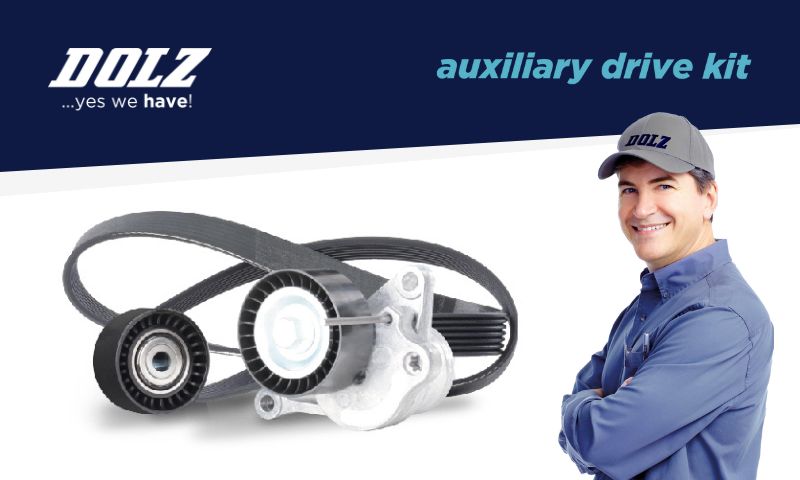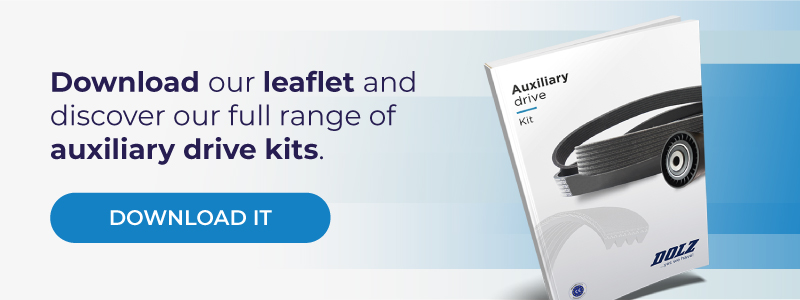When it comes to engine performance, ensuring the quality and strength of the aux drive belt and the auxiliary drive kit as a whole is key.
As this component of the vehicle works continuously when the engine is running, it is important to have access to a guaranteed auxiliary drive kit that offers optimal performance.
However, high temperatures, vibrations and the general wear and flexing over time all have an impact on the auxiliary drive belt, which translates into the need of a replacement and an aux belt installation.
In today’s article, learn how to perform an auxiliary belt installation and how to choose the right drive kit to ensure a longer lifespan.
Auxiliary drives: differences and types
The aux drive belt (as part of the whole auxiliary drive kit) is in charge of powering several key components in its periphery thanks to a pulley system, and that some are of vital importance such as the alternator.
There are two types of aux drive belt:
- Serpentine belt: shaped like an isosceles trapezoid in cross section, is characterized by being thinner and smaller and generally only drive one peripheral at a time.
- V-belt: also known as poly v, poly belt or poly vee belt, it represents the most efficient and long-lasting option today, as it solves slippage and alignments issues and presents less maintenance needs.
Related content: What does a car’s auxiliary drive belt do and why should you care?
Auxiliary drive kit replacement: step by step
The only way to know when it’s time to replace the auxiliary drive belt is to visually check its state of wear, not only of the drive belt but also of the other peripheral components. If the strap is worn, it will have cracks, fraying or irregularities of all kinds. Therefore, the periodic inspections of the auxiliary transmission belt represent a more than reliable method to make this decision, since its wear will depend, among other factors, on the use that is given to the vehicle and the temperatures that it works.
The auxiliary drive belt installation should then include the following steps:
-
- Disconnect the car battery to ensure safety during all operations. It’s also advisable to perform the aux belt installation when the engine is cold.
- While observing the current auxiliary drive belt kit, create a faithful representation of its routing and its configuration. Draw a sketch or take a picture of the routing. Also, look under the hood and around the engine compartment for the belt path and make sure you are familiar with the setup.
- In order to remove the auxiliary drive belt, you’ll first need to release the tension so that it can later slide off easily. Modern cars may use automatic tensioners that have a spring located inside with an oscillating arm that maintains pressure on the belt and moves always keeping the strap in place. If this is the case, use a crescent wrench or socket wrench to lock the tensioner into a retracted position. Other vehicles use tensioners or accessories that must be manually locked to provide the correct tension.
- Observe tensioners and pulleys to ensure they’re in good condition. Pulleys must be aligned, in order to avoid belt damage or noises, and automatic tools can be used for this.
- Jam nuts must be tight to the back of the bracket, ensuring a minimal torque.
- The new auxiliary drive kit must be installed following the configuration observed during step two. The accessories drive belt must be aligned with pulley grooves, in order to avoid belt damage.
- The correct tension must then be applied, which again can be done manually or automatically.
- Check the correct installation of the aux drive kit, then start the engine and let the transmission run for a few minutes. Check its operation through a drive test run.
Recommended: Dolz announces the addition of its new Auxiliary Drive Kits product line
Dolz, your trusted dealer for auxiliary drive kits
At Dolz we work to provide our customers with this competitive advantage by accessing our high-quality Auxiliary Drive Kits.
Designed to ensure great engine performance, they follow premium standards from original manufacturers such as Audi, Volkswagen, or Renault and include all the necessary components for a professional repair, that is all components are delivered in one package: V-ribbed belt or auxiliary belt, pulleys and idlers, drive tensioners all the necessary accessories depending on the vehicle application.
Get in touch with us to learn more about our quality standards and proven benefits of our auxiliary drive belt kits.


